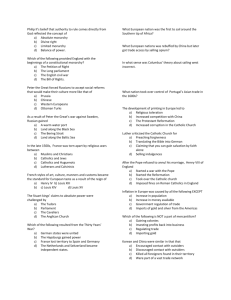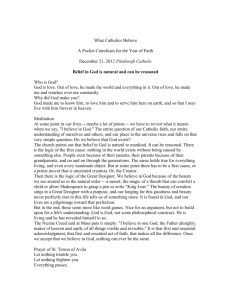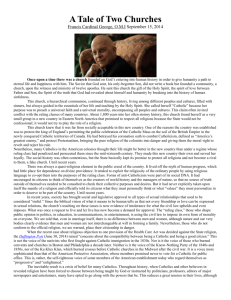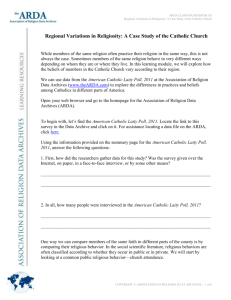The next meeting of the Canary Islanders Heritage Society of
advertisement
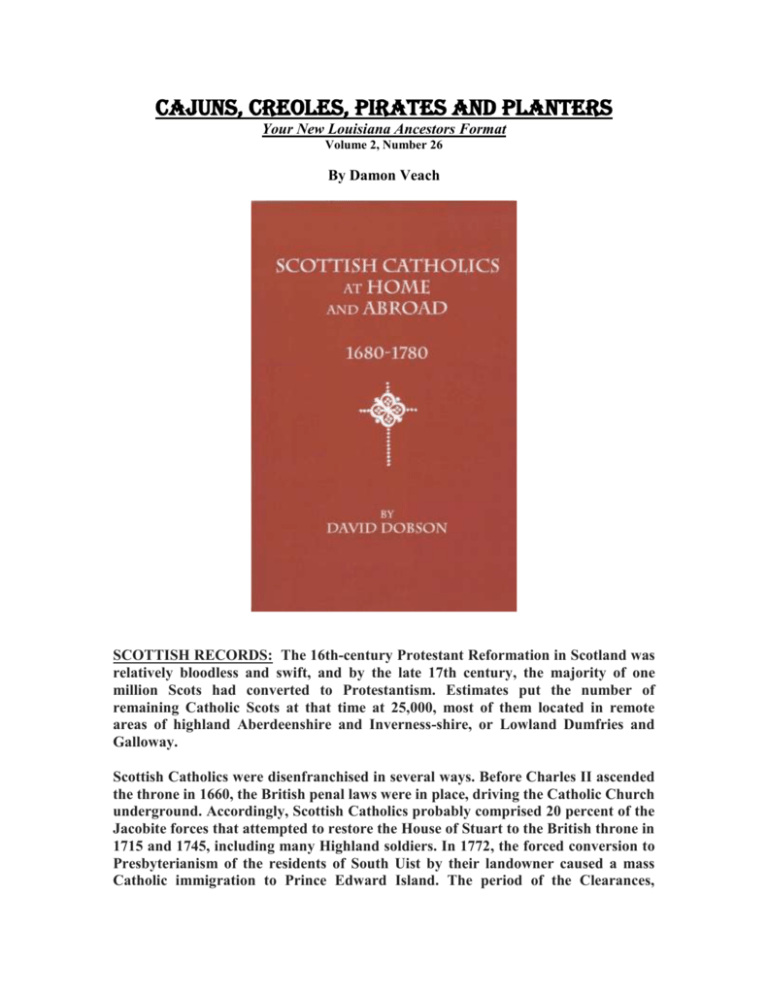
CAJUNS, CREOLES, PIRATES AND PLANTERS Your New Louisiana Ancestors Format Volume 2, Number 26 By Damon Veach SCOTTISH RECORDS: The 16th-century Protestant Reformation in Scotland was relatively bloodless and swift, and by the late 17th century, the majority of one million Scots had converted to Protestantism. Estimates put the number of remaining Catholic Scots at that time at 25,000, most of them located in remote areas of highland Aberdeenshire and Inverness-shire, or Lowland Dumfries and Galloway. Scottish Catholics were disenfranchised in several ways. Before Charles II ascended the throne in 1660, the British penal laws were in place, driving the Catholic Church underground. Accordingly, Scottish Catholics probably comprised 20 percent of the Jacobite forces that attempted to restore the House of Stuart to the British throne in 1715 and 1745, including many Highland soldiers. In 1772, the forced conversion to Presbyterianism of the residents of South Uist by their landowner caused a mass Catholic immigration to Prince Edward Island. The period of the Clearances, starting in the late 18th century, saw Catholic Highlanders immigrating to North America as part of an organized mass migration. While those who traveled to America for the most part remained there, a number of Scots Catholics traveled to the European mainland, including some who were destined for the priesthood. The repression of the Scottish Catholic Church has left the genealogist with few official records for identifying Scottish Catholics of this period. With the repeal of the penal laws in 1793, Catholic parish registers began to be kept. However, only four Catholic parish registers pre-date 1780 (Braemar from 1608, Kirkconnel from 1730, Ballater from 1769, and St. Mary’s Edinburgh from 1777). This dearth of parish registers convinced David Dobson to mine other sources in search of Catholic identities. Working from the Hudson Bay Records Archives, the National Archives in London and Edinburgh, the Scottish Catholic Archives in Edinburgh, various European archives, and a number of other repositories, Dr. Dobson has prepared an alphabetical list of about 2,000 Catholics who lived in Scotland between 1680 and 1780. In each case, the compiler cites the individual’s occupation, locality, a date and the source, and in many cases, the name(s) of parents, spouses, or children, where educated, and so on. At the end of the alphabetical sequence of native Catholics, researchers will find a second section of Scottish ships’ passenger lists that identify Catholics whom we know immigrated to North America. Scottish Catholics at Home and Abroad, 1680-1770 is an excellent soft-cover book and is now available from Clearfield Company, 3600 Clipper Mill Road, Suite 260, Baltimore, MD 21211. It is one of those books that should be in all major genealogical research collections, especially those larger libraries where so many gather for family history searches. It is priced at only $25.00, postpaid. XXX CEMETERY RECORDS: Carter County in eastern Tennessee was established in 1796 from Washington County. It was the parent county, in whole or in part, of Johnson and Unicoi counties. Dianne M. Snyder created this new DVD in order to help researchers locate ancestors who are buried in Carter County. The result of eight years of field work in Tennessee graveyards, Cemeteries of Carter County, Tennessee contains two related files. The DVD includes a full-color photographic record of all tombstones examined. The photographs are arranged alphabetically by surname and thereunder by cemetery. The genealogical heart of the work may be found in Snyder’s "Index,' the electronic equivalent of a 700-page volume. It is arranged alphabetically by cemetery and thereunder by decedent, and it concludes with a complete alphabetical listing of all names found on the stones. At the close of each cemetery transcription, researchers will find a “Notes” section. While the contents vary from cemetery to cemetery, the "Notes" provide details of the author’s own ancestors, evidence of whom prefigured the author’s acceptance into the DAR, Colonial Dames XVII Century, and the Jamestowne Society. Several other features commend this new DVD to the researcher’s attention. The DVD operates on the widely available Adobe Acrobat platform and is easy to use. Snyder explains the virtues of several finding aids for locating cemeteries in Carter County, including the use of GPS coordinates and the U.S. Geological Survey’s Geographic Names Information System. Since a number of recent burials are listed in the "Index," genealogists may be able to gather more information about those decedents from the Social Security Death Index. Finally, although the author has surveyed the overwhelming majority of cemeteries in Carter County, very large cemeteries, such as Roselawn Memorial Gardens, were beyond the scope of the project. Nonetheless, she has provided phone numbers of omitted cemeteries that will respond to queries. All in all, this is a massive accomplishment, one that will save genealogists days of tramping around the Carter County, Tennessee, countryside in search of elusive ancestors. The price of this DVD is $48.49 postpaid. It can also be ordered from the Clearfield Company, address above. XXX CANARY ISLANDERS: The next meeting of the Canary Islanders Heritage Society of Louisiana will be held on September 11, 11 o’clock at the State Archives Building on Essen Lane in Baton Rouge. The speaker will be Dr. Robb Mann, assistant professor in the Department of Geography and Anthropology at LSU. Dr. Mann will speak about his latest diggings at Galveztown settlement, one of the places the Canary Islanders settled upon their arrival in Louisiana. For more information, contact Rose Marie Powell, President, at 225-755-0422. XXX FREE SERVICE: Correspondence to this column should be directed to Damon Veach, Cajuns, Creoles, Pirates and Planters, 709 Bungalow Lane, Baton Rouge, LA 70802-5337. The e-mail address is ancestorslaveach@cox.net. Queries and book reviews are printed as space permits, and you are encouraged to take advantage of this free service. Claitor’s Publishing can serve as a distributor for self-published genealogy titles. Go to their homepage for details on how you can obtain this excellent service.
